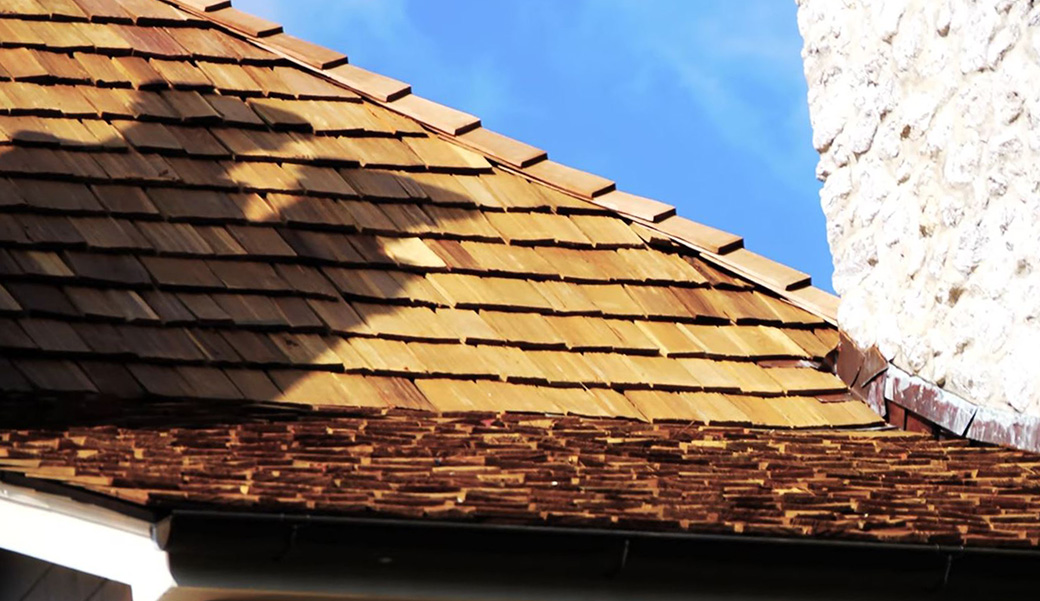A Simple Guide to Wood Shakes and Shingles
This particular type of roofing has been around for many, many years, and because of that, was once considered to be one of the most popular. Known for their more traditional and conventional look, they aren’t always the safest roofing type you could choose, especially in areas prone to fires.
Let’s take a closer look …

WHAT DO WOOD SHINGLES LOOK LIKE?
Wood shingles and wood shakes are not actually the same thing, although many property owners that we talk to certainly seem to think they are. The shingles are thinner than the shakes, and the they’re also the straighter-edged of the two, with a more refined cut line on each side. Shakes are meant to look more rustic and wood-like, and therefore have more of a “split” finish to them.
Because a wood roof needs a lot of ventilation in order to dry after rain, both shakes and shingles need to be applied on top of a surface that allows for spaces. If the sheathing itself has none of these spaces, air cannot flow through and the shingles or shakes will not dry. From there, you’ll have all sorts of problems, including wood rot, structural damage and weakening, and more.
One of the most important factors about wood roofing systems is that they are often the more aesthetically-pleasing option for traditional and/or rustic decor-lovers.
WOOD SHINGLES & SHAKES — THE PROS
As you can probably imagine, wood material roofing types are easy to recycle and reuse, making them an eco-friendly option when the time comes to replace a few shingles or shakes, or replace the entire roof. Unfortunately, this only applies when the shingles and shakes have not been treated with certain chemicals, one of which is pesticides. If that is the case, your roofing materials are likely to end up in landfill, just like their asphalt cousins.
Because of the nature of wood, this type of roof will work in cold areas, where a lot of insulation is needed. That’s only when the wood has been well-maintained, though, and because it’s wood, you may find that maintenance and repairs are necessary more frequently than with other types.
WOOD SHINGLES & SHAKES - THE CONS
Unfortunately, unless the wood shingles and shakes have been properly treated, they can fall prey to insect problems and wood rot. It’s also not advisable to have a wooden roof if you live in areas where the temperatures get very hot, for fear of house fires, and also in areas where wildfires are rife, such as in California. The wooden shakes and shingles are not going to be resistant to fire unless they are correctly treated to make them that way.
At the same time, climates that get a lot of rain or humidity might not be the best fit for a wood shingle or shake roof. It’s not the best kind of roof for lots of moisture, and unless you're willing to regularly treat the wood and have it inspected/repaired, it might not be the right one for you. At the same time, places that suffer with a lot of hail aren’t always best suited to wood material roofs -- the shakes and shingles are easily damaged by flying lumps of ice.
Finally, wood shingles and shakes tend to be quite a bit more expensive than other roofing types, particularly asphalt roofs. If we're looking at a traditional two-bedroom, upper level and lower level home, with approximately 2500 square feet to cover, an asphalt roof is going to cost around $7,000 or $8,000. A wood shingle roof would cost upwards of $15,000, and that's before you look at routine and regular maintenance or treatments.
Wood shingles are a big investment. They can add a lot of aesthetic appeal to the building, and also the neighborhood in some cases, but they do cost more to install and then maintain. Not always suitable for all areas, we recommend having a chat with us about your roofing needs to determine whether or not a wood shake or shingle roof would be a good fit.
Visit our Roof Contractor home page to learn more about us, or hire a local professional from over 100 USA locations.

